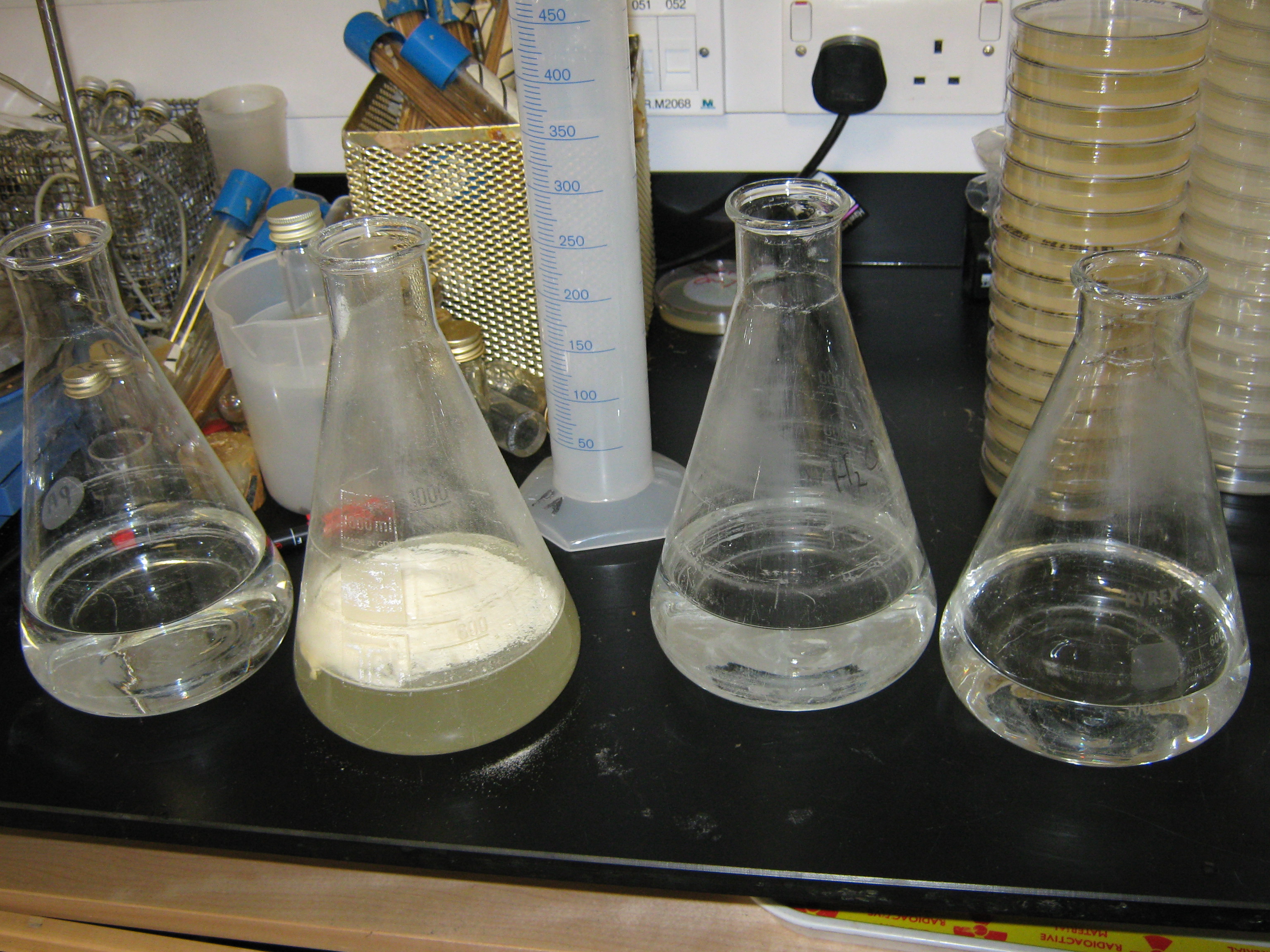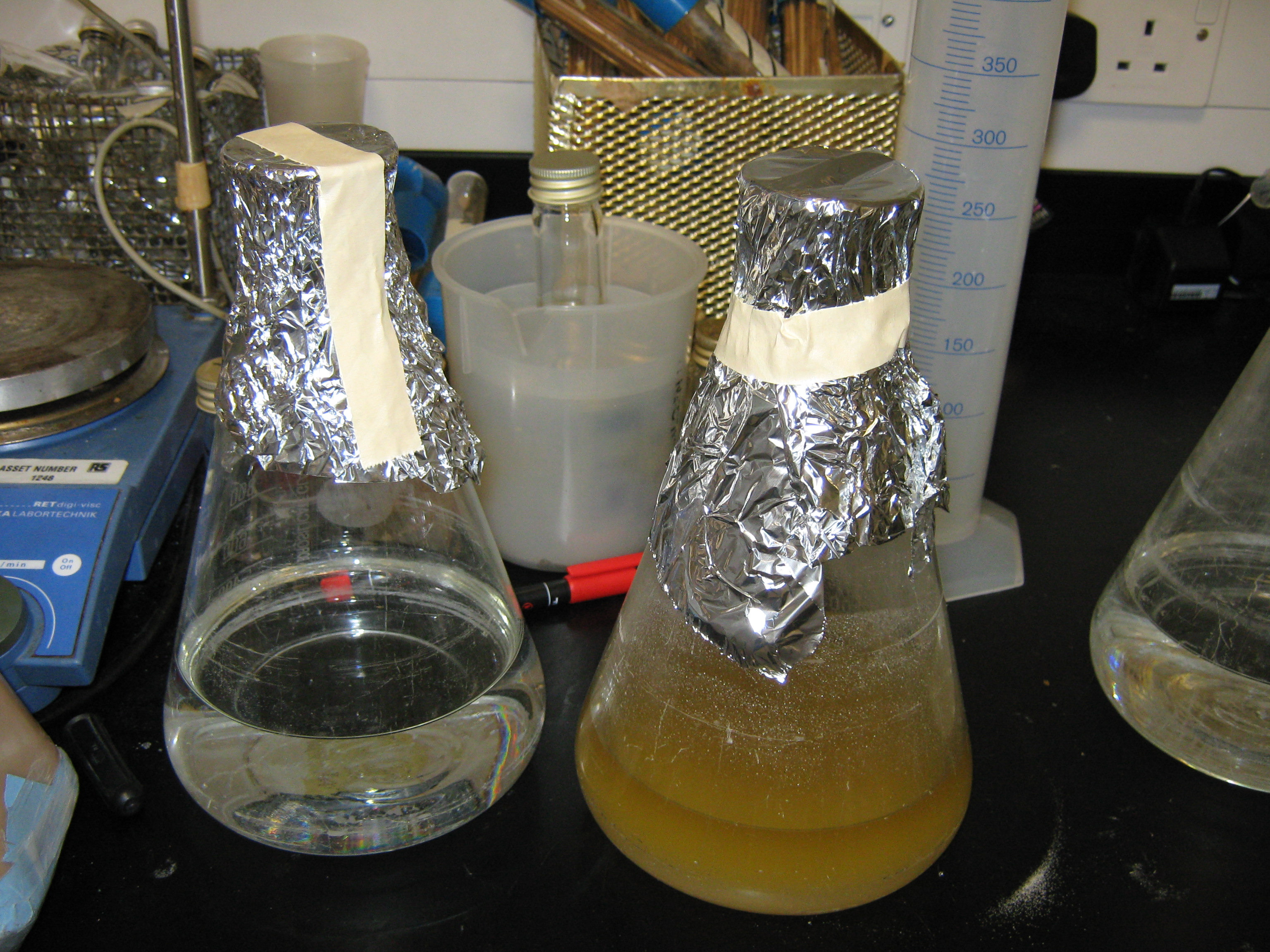Team:Newcastle/Labwork/14 August 2009
From 2009.igem.org
(→Work we did) |
Babyneurone (Talk | contribs) (→Introduction and Summary) |
||
| (28 intermediate revisions not shown) | |||
| Line 2: | Line 2: | ||
{{:Team:Newcastle/Header}} | {{:Team:Newcastle/Header}} | ||
{{:Team:Newcastle/Left}} | {{:Team:Newcastle/Left}} | ||
| - | =Lab 14 | + | __NOTOC__ |
| + | [[Image:Team Newcastle 2009 iGEM ProbationaryP-Sign.PNG|50px|right]] | ||
| + | =Formal Lab Session - 14th August 2009= | ||
| + | [[Image:Team Newcastle 2009 iGEM 14-08-09 IMG 0394.JPG|350px|center]] | ||
| - | ==Metal Sensor Team== | + | =<font color="Orange"><u>Overview</u></font>= |
| + | <font color="Orange"> | ||
| + | *[[#Metal Sensor Team|Metal Sensor Team]] '''- prepared some LB + Chloramphenicol + starch plates and added ''pGFP-rrnB'' ''B. subtilis'' transformants to it ''' | ||
| + | </font> | ||
| + | <br> | ||
| + | ==<u>Metal Sensor Team</u>== | ||
===Introduction and Summary=== | ===Introduction and Summary=== | ||
| - | So far we have shown that our ''Bacillus subtilis 168'' cultures, once the '' | + | |
| + | So far we have shown that our ''Bacillus subtilis 168'' cultures, once the ''pGFP-rrnB'' DNA has been added, can survive on LB + Chloramphenicol media. This suggests that we have successfully transformed our ''B. subtilis'' cells as the wild type ''B. subtilis'' cells do not have this resistance. However we need to prove that the resistance inherited by the ''Bacillus subtilis'' bacteria is due to the ''GFP-rrnb'' and not acquired by other means. '''Today, we intend to pour some LB + Chloramphenicol + starch plates and then plate our 'transformed' ''Bacillus'' cells onto these plates.''' The reason for adding starch to the plates: the ''GFP-rrnb'' plasmid removes the ''Bacillus subtilis'' bacteria's ability to break down starch using the ''amyE'' enzyme - starch plates will prove the bacteria have been transformed. | ||
| + | |||
| + | ===Changes to protocol=== | ||
| + | There were no changes to the protocol described [https://2009.igem.org/Team:Newcastle/Project/Labwork/OurProtocols/Making_Agar_Plates#Making_up_starch_plates here] except for the fact that the chosen antibiotic is chloramphenicol | ||
===Work we did=== | ===Work we did=== | ||
| - | * Using the 'pouring plates' protocol, we made up 1 litre of LB + agar + starch solution and once it had been autoclaved and properly prepared (with chloramphenicol - this is the resistance displayed in ''GFP-rrnB''), the solution was poured into plates. | + | [[Image:Team Newcastle iGEM 2009 14-08-09 IMG 0403.JPG|thumb|200px|Two 1 litre flasks - one containing 500ml LB + agar with starch also present and the other flask containing 500ml of deionised water]] |
| + | [[Image:Team Newcastle iGEM 2009 14-08-09 IMG 0421.JPG|thumb|200px|Mathew pouring the LB starch + chloramphenicol plates under aseptic technique]] | ||
| + | * Using the [https://2009.igem.org/Team:Newcastle/Project/Labwork/OurProtocols/Making_Agar_Plates#Making_up_starch_plates 'pouring plates' protocol], we made up 1 litre of LB + agar + starch solution and once it had been autoclaved and properly prepared (with chloramphenicol - this is the resistance displayed in ''GFP-rrnB''), the solution was poured into plates. | ||
<br> | <br> | ||
| - | * These plates were then left on the bench for 1 hour. Three plates were taken from the stack and placed in the | + | * These plates were then left on the bench for 1 hour. Three plates were taken from the stack and placed in the 42ºC incubator to dry off. |
| + | <br> | ||
| + | * Once the plates had dried, a grid of 46 squares was drawn onto the base of the plate. These squares were then numbered from 1-46. | ||
| + | <br> | ||
| + | * Within square 1, a mark was made in the agar surface (in the shape of an 'X')with wild type ''Bacillus subtilis''. | ||
| + | <br> | ||
| + | * Within squares 2-46, marks were also made on the agar surface but this time it was with our transformed ''Bacillus subtilis'' (which should have taken up ''gfp-rrnb'') | ||
| + | <br> | ||
| + | * The plate was then left in the 37ºC incubator overnight. | ||
| + | |||
| + | {{:Team:Newcastle/Project/Labwork/CalTemplate}} | ||
| + | |||
{{:Team:Newcastle/Footer}} | {{:Team:Newcastle/Footer}} | ||
{{:Team:Newcastle/Right}} | {{:Team:Newcastle/Right}} | ||
Latest revision as of 12:06, 20 August 2010
Formal Lab Session - 14th August 2009
Overview
- Metal Sensor Team - prepared some LB + Chloramphenicol + starch plates and added pGFP-rrnB B. subtilis transformants to it
Metal Sensor Team
Introduction and Summary
So far we have shown that our Bacillus subtilis 168 cultures, once the pGFP-rrnB DNA has been added, can survive on LB + Chloramphenicol media. This suggests that we have successfully transformed our B. subtilis cells as the wild type B. subtilis cells do not have this resistance. However we need to prove that the resistance inherited by the Bacillus subtilis bacteria is due to the GFP-rrnb and not acquired by other means. Today, we intend to pour some LB + Chloramphenicol + starch plates and then plate our 'transformed' Bacillus cells onto these plates. The reason for adding starch to the plates: the GFP-rrnb plasmid removes the Bacillus subtilis bacteria's ability to break down starch using the amyE enzyme - starch plates will prove the bacteria have been transformed.
Changes to protocol
There were no changes to the protocol described here except for the fact that the chosen antibiotic is chloramphenicol
Work we did
- Using the 'pouring plates' protocol, we made up 1 litre of LB + agar + starch solution and once it had been autoclaved and properly prepared (with chloramphenicol - this is the resistance displayed in GFP-rrnB), the solution was poured into plates.
- These plates were then left on the bench for 1 hour. Three plates were taken from the stack and placed in the 42ºC incubator to dry off.
- Once the plates had dried, a grid of 46 squares was drawn onto the base of the plate. These squares were then numbered from 1-46.
- Within square 1, a mark was made in the agar surface (in the shape of an 'X')with wild type Bacillus subtilis.
- Within squares 2-46, marks were also made on the agar surface but this time it was with our transformed Bacillus subtilis (which should have taken up gfp-rrnb)
- The plate was then left in the 37ºC incubator overnight.
|
| |||||||||||||||||||||||||||||||||||||||||||||||||||||||||||||||||||||||||||||||||||||||||||||||||
|
| |||||||||||||||||||||||||||||||||||||||||||||||||||||||||||||||||||||||||||||||||||||||||||||
News
Events
- 20 – 21 June 2009 - Europe workshop (London)
- 23 – 24 June 2009 - UK iGEM meetup (Edinburgh)
- 23 October Practice Presentation (Newcastle)
- 23 October T-shirts are ready
- 27 October Practice Presentation (Sunderland)
- 27 October Poster is ready
- 30 October – 2 November 2009 - Jamboree (Boston)
Social Net
- Newcastle iGEM Twitter
- [http://www.facebook.com/home.php#/group.php?gid=131709337641 Newcastle on Facebook]
- [http://www.youtube.com/user/newcastle2009igem Newcastle Youtube Channel]
 "
"



